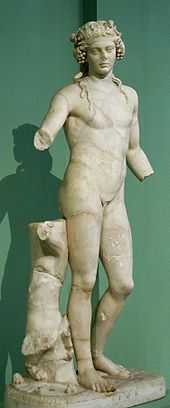Horti Liciniani

Dionysus of Pentelic marble discovered in the nymphaeum, 1879 (Capitoline Museums)
The Horti Liciniani[1] were a set of gardens in ancient Rome originally belonging to the gens Licinia. In the third century, these were owned by the Emperor Gallienus,[2] himself a member of the gens. The gardens were probably on the Esquiline Hill, at the top of which Gallienus erected a colossal statue of himself.[3] The 4th-century domed nymphaeum that survives, long miscalled a "Temple of Minerva Medica", is believed to have been part of the gardens.
Notes
- ↑ Maddalena Cima, "Gli Horti Liciniani: una residenza imperiale nella tarda antichità", in Horti Romani, Atti del Convegno Internazionale Roma, 4-6 maggio 1995, Eugenio La Rocca, ed. (Rome), 1998.
- ↑ Historia Augusta, "Gallienus", 17.
- ↑ in summo Esquiliarum monte ibid, 18. The Palatium Licinianum stood near the site of the church of Santa Balbina; an arcus Gallieni stood at the Esquiline gate (porta Esquilina LacusCurtius.com: Horti, with bibliography